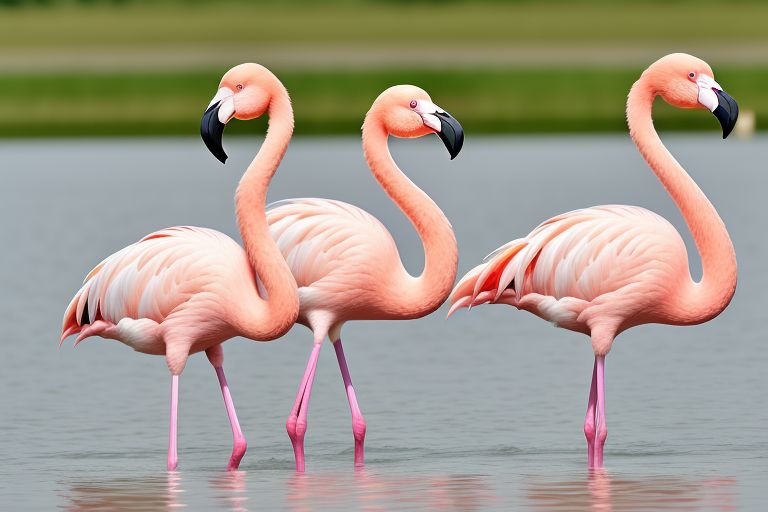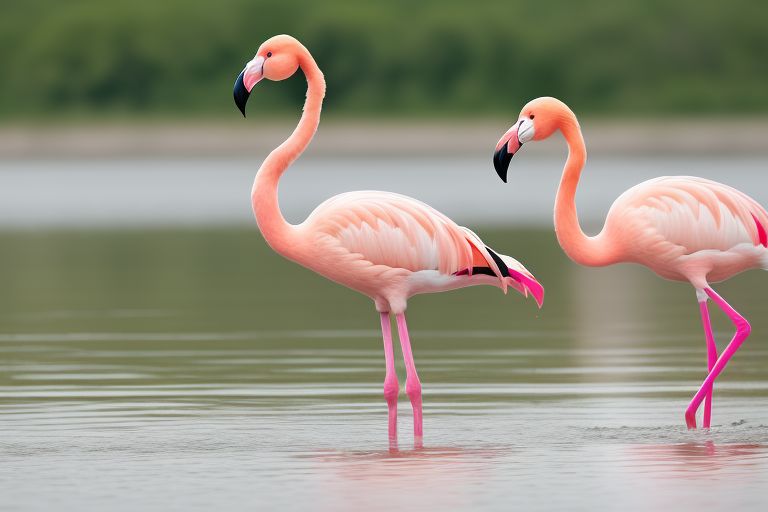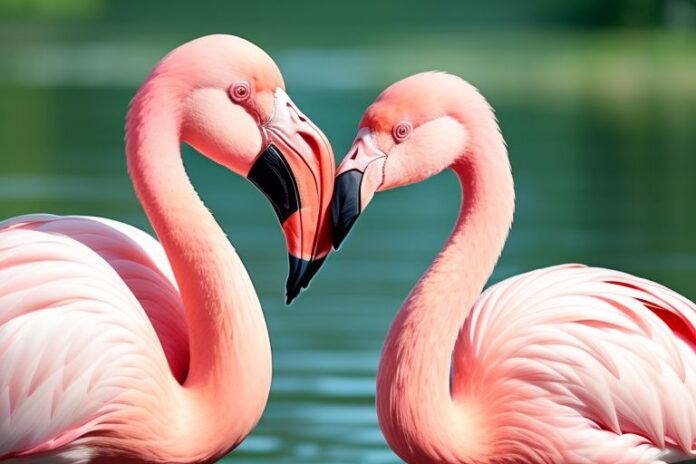Why does a flamingo lose its pink? It’s a question many people ask when they see flamingos changing color. Flamingos are famous for their beautiful pink feathers, but they don’t always stay pink! The color of a flamingo’s feathers can change depending on what they eat and their environment.
Flamingos get their pink color from their diet, which is rich in carotenoids found in algae and shrimp. But, if their diet changes or they don’t have enough carotenoids, their feathers can become pale or even white. In this article, we’ll explore why flamingos lose their pink color and what this can tell us about their health and surroundings.
What Causes Flamingos to Lose Their Pink Color?
Flamingos are known for their stunning pink feathers, but you might wonder, “Why does a flamingo lose its pink?” The reason for this is mainly their diet. Flamingos eat algae, brine shrimp, and other small animals that contain a red-orange pigment called carotenoid. This pigment gives them their pink color. Without enough of these foods, their feathers become paler, and they might even turn white!
The flamingo’s body processes these pigments, storing them in the liver and depositing them into the feathers. However, when the flamingos’ diet lacks carotenoids, they can lose their vibrant pink color. This is why flamingos in different parts of the world may appear paler or even white.
The Role of Diet in Flamingos’ Color Change
Flamingos’ colors are heavily influenced by what they eat. In their natural habitats, flamingos consume lots of algae and tiny crustaceans that are rich in carotenoids. So, when you ask, “Why does a flamingo lose its pink?” it’s all about what’s on the menu! Without these carotenoid-rich foods, flamingos can’t keep their pink color.
- Algae and Carotenoids: The pigments in algae are key to the flamingo’s pink appearance.
- Shrimp and Crustaceans: These also help in maintaining the color.
- Change in Diet: A change in diet, like fewer carotenoids, can cause the pink color to fade.
If the flamingo’s diet doesn’t have enough carotenoids, it will lose its pink hue and may look pale or even white. This can happen in captivity or in regions where food sources are different.
How Lack of Carotenoids Affects Flamingos’ Pinkness
Carotenoids are the reason flamingos are pink. These natural pigments are found in the algae and crustaceans they eat. So, if a flamingo’s diet doesn’t have enough carotenoids, it can lose its pinkness. This is a big part of the answer to, “Why does a flamingo lose its pink?” When flamingos aren’t getting enough carotenoids, their feathers will start to fade to a pale color.
- Carotenoids: These pigments are essential for the flamingo’s bright pink feathers.
- Color Fading: Without enough carotenoids, flamingos turn lighter or white.
- Health: Not getting carotenoids can also mean poor health for flamingos.
This process is natural and happens when flamingos cannot get the foods they need to maintain their color. If flamingos are in an area with less food rich in carotenoids, they might show up with less vibrant feathers.
Why Do Some Flamingos Lose Their Pink After Breeding?

Flamingos often lose their pink color after breeding. But why does a flamingo lose its pink after this time? During breeding season, flamingos may stop eating their normal carotenoid-rich diet. This is because they are focused on nesting and caring for their chicks. As a result, they can lose some of the pink pigmentation in their feathers.
- Breeding Changes: Flamingos often change their diet during breeding.
- Focus on Chicks: They may not have enough carotenoids during this time.
- Color Fade: After breeding, their feathers can become paler.
This color change is completely natural and can happen in both wild flamingos and those in zoos or other controlled environments. The loss of pink color after breeding doesn’t mean the flamingos are unhealthy; it’s simply a result of their lifestyle during that time.
Can Flamingos Regain Their Pink Color?
Yes, flamingos can regain their pink color! If they return to eating a diet rich in carotenoids, their feathers will slowly regain their vibrant pink hue. However, this process can take a while. When flamingos have a good diet full of algae, brine shrimp, and other carotenoid-rich foods, the pigments will gradually return to their feathers.
How Flamingos Can Regain Pink Color:
- Diet: Returning to a carotenoid-rich diet.
- Patience: It takes time for the feathers to regain their color.
- Healthy Diet: Flamingos need consistent access to food full of carotenoids.
The key to flamingos getting their color back is eating foods rich in the same pigments that cause their vibrant pink. This change can take a few weeks or even months to fully restore the pink color.
Are There Flamingos Without Pink Feathers?
While it’s rare, there are some flamingos that don’t have pink feathers. These flamingos may suffer from a lack of carotenoids or live in an environment where these pigments are hard to find. If a flamingo doesn’t get enough carotenoids, it may never achieve its iconic pink color. Some flamingos even appear white or pale.
- No Carotenoids: A lack of carotenoids means no pink.
- Rare Cases: Some flamingos remain pale their whole lives.
- Health Issues: This could also be a sign of poor health or malnutrition.
These cases are rare, but they remind us just how important a flamingo’s diet is to its appearance. Flamingos without the right foods often don’t develop the vibrant pink feathers we associate with them.
How Flamingos’ Habitat Affects Their Pink Color
The habitat of flamingos plays a significant role in the color of their feathers. Flamingos are typically found in wetlands, salt lakes, and coastal areas where they can find plenty of food like algae, shrimp, and other small crustaceans. The presence of these food sources directly impacts how pink their feathers will be. The abundance of carotenoids in their environment is crucial to maintaining their distinctive color.
Flamingos that live in regions with a rich supply of algae and brine shrimp tend to have brighter, deeper pink hues. On the other hand, flamingos that live in places with fewer carotenoid-rich food sources will appear paler. For example, flamingos found in the Caribbean often have bright red or orange feathers due to the abundance of carotenoids in the algae they consume, while flamingos living in drier, less nutrient-dense areas might have lighter pink or even white feathers.
- Algae and Shrimp: These are the main food sources responsible for flamingos’ pinkness.
- Wetlands and Coastal Areas: Flamingos thrive in these environments, which are rich in nutrients.
- Diet Variations: The availability of food directly impacts their feather color.
Even in captivity, the diet provided to flamingos plays a significant role. If the food they receive lacks carotenoids, the flamingos may lose their signature color. This is why it’s essential to provide flamingos in zoos or reserves with a diet that mimics what they would eat in the wild.
The Connection Between Flamingos’ Color and Their Health

Flamingos’ health is closely tied to their diet, and this can affect their color as well. A healthy flamingo with a proper diet will have bright pink feathers, while one that lacks the necessary nutrients may have pale or white feathers. This change in color is a natural response to an imbalance in their diet or health. If a flamingo isn’t getting enough carotenoids, it may indicate poor health, which can affect its overall well-being.
Additionally, flamingos’ health can also be influenced by environmental factors. Pollution, climate change, or the depletion of certain foods in their habitat can lead to a decrease in the carotenoid levels in their diet. This reduction can, in turn, cause their feathers to lose their color. Flamingos in poor health may also appear weak, which is why their feather color can be an indicator of their overall condition.
- Carotenoid Deficiency: Lack of carotenoids can lead to pale feathers and poor health.
- Pollution and Habitat Loss: These can reduce food availability, affecting flamingos’ health.
- Feathers as Health Indicators: A flamingo’s feather color can reflect its health.
Therefore, the question “Why does a flamingo lose its pink?” also ties into concerns about the overall health and survival of these beautiful birds. Ensuring they have access to the right foods in the right environments is essential for maintaining both their color and their health.
Can Flamingos Be Rehabilitated to Regain Their Pink Color?
When flamingos lose their pink color due to malnutrition or diet changes, there is a possibility of rehabilitation. By providing flamingos with a diet that’s rich in carotenoids, they can gradually regain their vibrant color. This process, however, takes time. If a flamingo has been deprived of the correct food for a while, it can take several weeks or even months before its feathers show signs of improvement.
The rehabilitation process is most effective when done in an environment where flamingos are provided with food sources like algae and shrimp that are high in carotenoids. Zoos and wildlife reserves are often able to carefully monitor flamingos’ diets and ensure they receive the necessary nutrients to regain their color.
- Time-Consuming Process: Rebuilding their color can take weeks or months.
- Proper Diet: It’s essential to feed flamingos foods rich in carotenoids.
- Monitoring Health: Flamingos should be closely observed during rehabilitation.
Rehabilitation doesn’t just restore their pink feathers, but it also helps ensure that flamingos are healthy and able to thrive in their environment. The right care and food will eventually help bring back the flamingo’s iconic color, restoring its beauty and health.
Conclusion
In conclusion, the reason why a flamingo loses its pink color is closely tied to its diet and health. Flamingos get their vibrant pink feathers from the food they eat, like algae, shrimp, and crustaceans. If they don’t get enough carotenoids, which are found in these foods, their feathers may turn pale or white. So, the color of a flamingo is not just about beauty but also about how healthy and well-fed it is.
Taking care of flamingos and providing them with the right food is important for keeping their pink color. In the wild and in captivity, the right habitat and diet help flamingos stay healthy and colorful. So, whenever we see a flamingo with bright feathers, we can be sure that it’s getting all the nutrients it needs to stay strong and beautiful.
FAQs
Q: Why do flamingos turn pink?
A: Flamingos turn pink because they eat food like algae and shrimp that contain a red-orange pigment called carotenoids.
Q: Can flamingos lose their pink color?
A: Yes, flamingos can lose their pink color if they don’t get enough carotenoids in their diet.
Q: How do flamingos get their color back?
A: Flamingos can regain their pink color by eating a diet rich in carotenoids, such as algae and shrimp.
Q: Does the habitat of flamingos affect their color?
A: Yes, flamingos living in places with more carotenoid-rich food tend to have brighter pink feathers.
Q: Are flamingos born pink?
A: No, flamingo chicks are born with grey feathers and gradually turn pink as they eat food rich in carotenoids.

